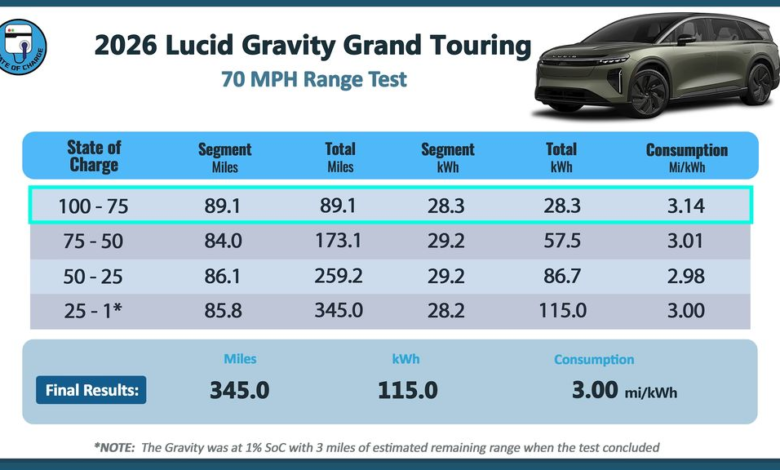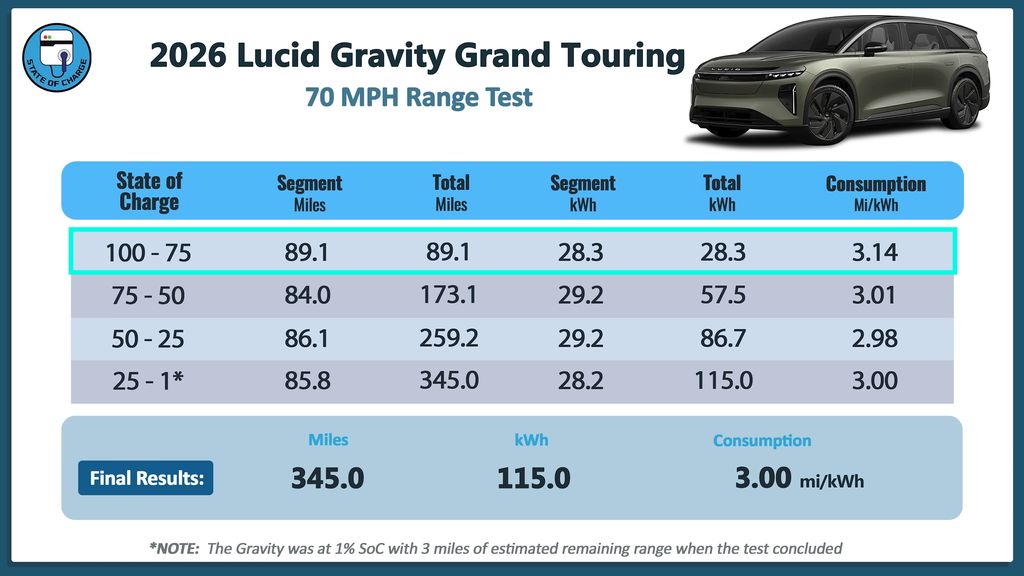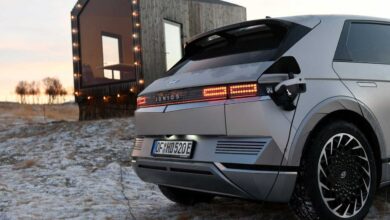‘Not Quite As Expected,’ And Here’s Why

- The Lucid Gravity SUV is rated to be a long-distance champion at 450 miles of EPA-rated range.
- But State of Charge’s Tom Moloughney did the usual 70 mph run down to nearly empty, and achieved 345 miles at 3.0 miles per kilowatt-hour—not Lucid’s usual landmark efficiency.
- Tom got in touch with Lucid’s engineers, and the carmaker says there may have been a problem with the SUV’s rear drive unit.
On paper, the new Lucid Gravity SUV seems hard to beat, so long as you have the cash for one. It’s rated at up to 450 miles of electric range, will do zero to 60 mph in just 3.4 seconds and packs luxury and technology features that could send Lexus spiraling into an existential crisis.
But as with many EVs, there’s often a gulf between those ambitious range claims and real-world performance. And in his latest 70 mph highway range test, InsideEVs Contributing Editor and State of Charge host Tom Moloughney found that the Gravity can really go the distance on the highway—just far short of what it’s supposed to do.
As a quick refresher, the Gravity is just now going on sale. It’s only Lucid Motors’ second vehicle, ever, but it’s more than just an SUV version of the class-leading Lucid Air sedan. It uses an entirely new platform and an array of new technologies that evolve beyond what its older brother can do.
The sole model currently for sale, the Gravity Grand Touring, delivers 450 miles of range thanks to a 123-kilowatt-hour battery pack, electric motors developed in-house, highly efficient packaging and a super-aerodynamic design. Starting at about $96,000, it isn’t cheap, but it’s as tip-of-the-spear high-tech as EVs get outside of China.
As always, Tom is here to do the Lord’s work by running the Gravity down to nearly empty at a continual 70-71 mph. (I worry about his bladder, too, especially as EV range gets better and better.) The tires are set to the manufacturer’s suggested spec, and this Gravity also packs the smallest and most aerodynamic wheels available. It’s a colder early fall evening with temperatures in the 50s, but doing these tests at night helps Tom avoid the New Jersey traffic.
After hours of driving, Tom pulls the Gravity into a Tesla Supercharger station, where he unfortunately has trouble initiating a charge. This was at 3 a.m. and the SUV was at 0%, but he miraculously limped it to an Electrify America station, where a charge session finally worked and allowed him to drive home.
The man puts in the work, folks.

Photo by: State Of Charge
But the work from the Gravity isn’t quite as inspiring. It managed 345 miles of highway driving at 3.0 miles per kWh, which is not only far below estimates but not exactly mind-blowing efficiency from Lucid. While it’s unreasonable to expect an SUV to pull the same 4.0-plus ratings as the Air sedan, the carmaker did claim a target of about 3.6 miles per kWh. Not exactly what Tom got here.

Photo by: Patrick George
It’s also worth noting that I have a forthcoming review of this exact same Gravity, and I almost never saw ratings above 3.0 miles per kWh, either. I too wasn’t blown away by its efficiency, even if I drove it more aggressively than Tom probably did.
Let’s be reasonable here: 345 miles on the highway is an excellent result for a modern EV. These days, 300 miles of total range should be table stakes for most family SUVs. But the EPA’s testing cycle is a standardized mix of city and highway driving. Just about any EV will fall short of that rating when continuously driven at 70 mph on the highway—though several now can actually outperform those estimates, too.
However, falling short of the total estimated range by more than 100 miles is a disappointing result. Especially so for Lucid, which bills itself as the king of efficient electric driving.
But there may be an explanation here. Tom got in touch with Lucid’s engineers. “When the engineers took at look at the full range test, they noticed there’s actually a problem with the rear drive unit of this vehicle,” Tom said. “That likely impacted the results of this range test.”
They added that the Gravity shouldn’t have read 0% at the end of Tom’s test, as he still had about 6 kWh of battery capacity left to run. And while carmakers often reserve a portion of the total battery capacity as a kind of buffer, Tom was surprised it was that high. “That’s a huge low-end buffer,” he said. “I don’t think that’s exactly how the vehicle is set up to be, normally.”
Lucid has since offered to send Tom another vehicle for a re-test, which we will also run when he can. That won’t be for a while for scheduling reasons, and when it does, I hope the Gravity yields a better result. It’s an impressive SUV, but it has a handful of teething issues out of the gate, as many brand-new EVs do. With any luck, they’ll be ironed out soon.
Contact the author: patrick.george@insideevs.com
Source link

